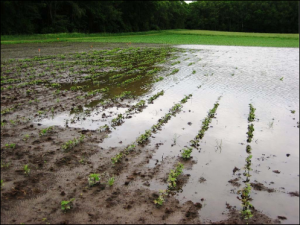Contact: Heidi Johnson, 608-285-2142, heidi.j.johnson@wisc.edu

Photo courtesy of Shawn Conley
This wet spring is creating many challenges for farmers and setting them up to have to make some tough decisions according to University of Wisconsin-Madison Division of Extension experts.
Extension specialists and educators offer resources for farmers and agricultural consultants to assist in making informed business decisions. The Extension Crops and Soils website https://fyi.extension.wisc.edu/grain/extreme-weather/#wetspring is continuously updated with articles and videos related to the current planting situation. The site also lists Extension crops and soils specialists and educators across the state who are available to help farmers get the answers related to this spring’s challenges.
“Only a percentage of crops have been planted so farmers will need to decide what they might plant when they can actually get into fields and how that choice will affect their enrollment in farm programs and crop insurance,” said Heidi Johnson, Extension Interim Agriculture Institute Director.
The USDA National Agricultural Statistics Service (NASS) crop progress reports for Wisconsin indicate that as of May 26, 2019, 46 percent of corn has been planted compared to 77 percent one year ago and that 20 percent of soybeans have been planted compared to 59 percent one year ago.
A cold winter also led to mass winter kill of the alfalfa crop in a year when livestock and dairy producers were already facing diminished feed inventories from weather conditions last year. The Extension website also provides resources on choosing and managing alternative and emergency forages and options for managing partially-killed alfalfa fields.
###



